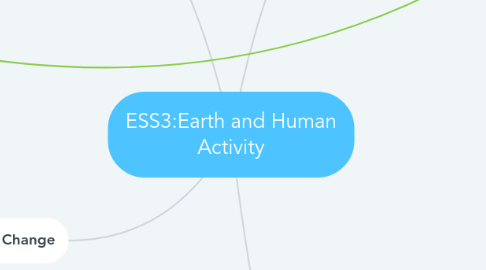
1. ESS3.C-Human Impacts on Earth
1.1. Technology
1.2. Protecting Endangered Species
1.3. Cleaning Lakes/Oceans
1.4. Pollution
1.5. Rising temperatures
1.6. burning fossil fuels
2. ESS3. D-Global Climate Change
2.1. Temperature
2.2. Water Scarcity
2.3. Shifting climate
2.3.1. heat waves
2.3.2. wildfires
2.3.3. expansion of deserts
2.3.4. increased rate of evaporation
2.4. climate sensitivity
2.4.1. snow cover loss
2.4.2. increased water vapor
2.5. extinction/relocation
2.5.1. ecosystems
2.5.1.1. coral reefs
2.5.1.2. mountains
2.5.1.3. the Arctic
2.6. mitigation
2.6.1. low carbon energy technologies
2.6.2. forest preservation
2.6.3. climate engineering technologies
2.6.4. disaster management
3. ESS3.A-Natural Resources
3.1. Minerals
3.1.1. Metals
3.1.1.1. Iron
3.1.1.2. Copper
3.1.1.3. Aluminum
3.1.2. Non metals
3.1.2.1. Salt
3.1.2.2. Gypsum
3.1.2.3. Clay
3.1.2.4. Sand
3.1.2.5. Phosphates
3.2. Forests
3.2.1. tropical rain forests
3.2.1.1. industry
3.2.1.1.1. rubber
3.2.1.1.2. oils
3.2.1.1.3. gum
3.2.1.1.4. waxes
3.2.1.1.5. flavorings
3.2.1.1.6. dyes
3.2.1.2. medicine
3.2.1.2.1. cures for diseases
3.2.2. temperate
3.2.2.1. varied temperatures
3.2.2.1.1. 4 seasons
3.2.2.1.2. winter-freezing temperatures
3.2.2.1.3. higher heat
3.2.2.1.4. humidity
3.2.3. boreal
3.2.3.1. Flora
3.2.3.2. Fauna
3.3. Water
3.3.1. Lakes
3.3.2. Oceans
3.3.3. Rivers
3.4. Soil
3.4.1. mineral
3.4.2. air
3.4.3. water
3.5. Air
4. ESS3.B-Natural Hazards
4.1. geological hazards
4.1.1. Avalanche
4.1.2. Earthquake
4.1.3. Coastal Erosion
4.1.4. Lahar
4.1.5. Landslide
4.1.6. Sinkhole
4.1.7. Volcanic Eruption
4.2. climate hazards
4.2.1. Blizzard
4.2.2. Drought
4.2.3. Hailstorm
4.2.4. Heat Wave
4.2.5. Cyclonic Storm
4.2.6. Ice Storm
4.2.7. Tornado

